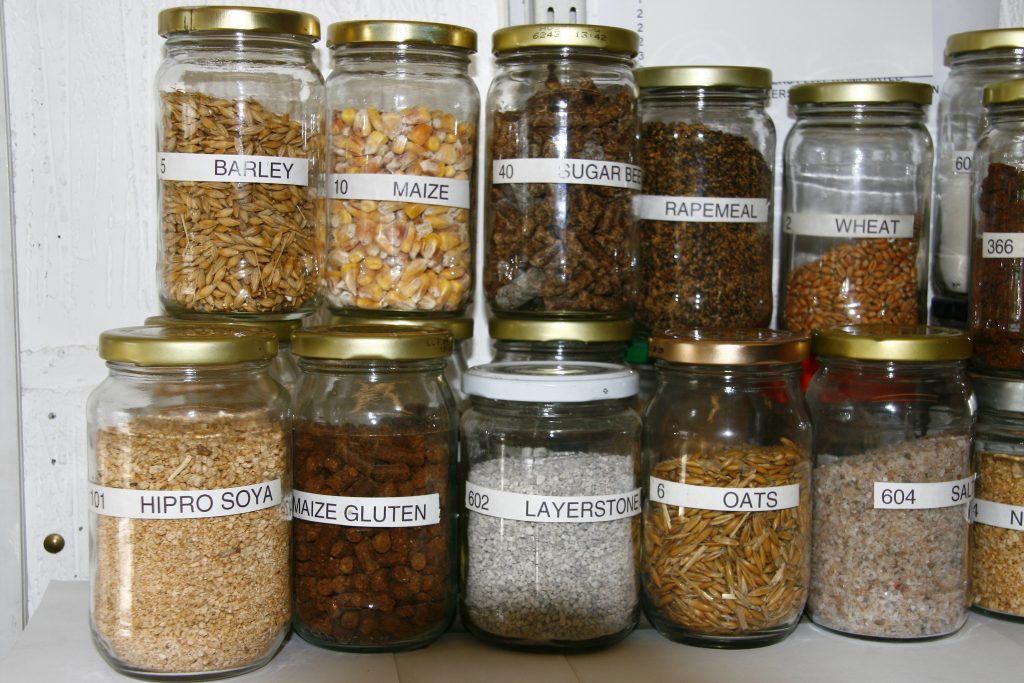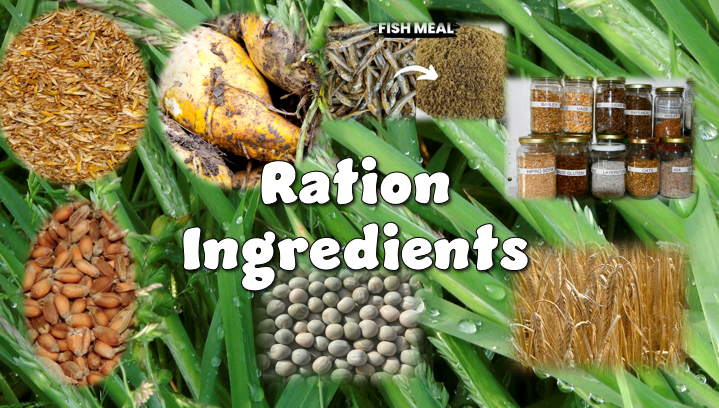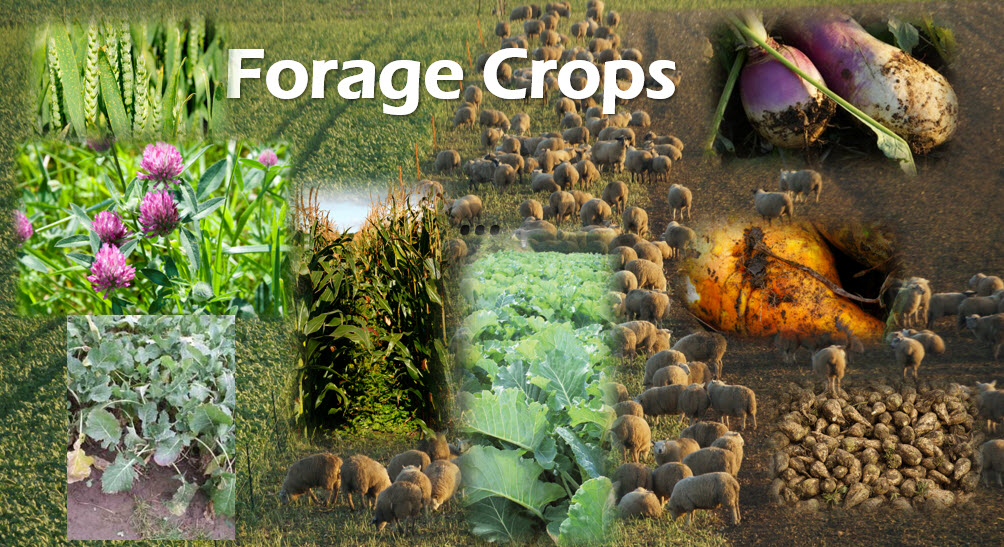Nutritional Requirements
(headline guide)
(These are general target ranges — animals and systems vary)
| ME (MJ DE/Kg) | CP (%) | |
| Dairy | 11-12 | 14-18 |
| Beef | 10-12 | 11-16 |
| Pig: Weaned | 14.4-15 | 18-22 |
| Pig: Grower | 13.4-14.2 | 16-19 |
| Pig: Finisher | 13-14 | 14-16 |
| Sow: Gestation | 14 | 13-13.5 |
| Ewe: Late Gestation | 11.0-12.5 | 14-18 |
| Ewe: Lactating | 11.5-13 | 16-19 |
| Lamb: Finishing | 12-13 | 14.19 |
Metabolisable Energy (ME) MJ/kg DM
Crude Protein (CP) % DM
Always work with ration software, nutritionist, or feeding tables for exact formulation. On-farm forage analysis is crucial.
| Quick reference cheat-sheet (copy for your pocket) |
| Grain moisture safe storage: aim ≤14–15% (check buyer). OSR moisture: aim low (often <9–10%) to avoid heating. Silage DM: target ~28–35% for clamp silage (varies). Bale silage higher. Hay DM: >85% before baling. Store principle: dry + cool + clean + sealed + monitor. |
| Record-keeping & legal/health notes |
|---|
Keep records of deliveries, analysis results, treatments (e.g., preservatives), and pest control actions. Follow product labels and COSHH/health & safety when using preservatives, fumigants, or sprout inhibitors. For medicated feeds, follow withdrawal periods and legal storage/feeding records. |
Livestock Feeds — Quality & Storage

Quick intro
Good feed = healthy animals = better performance = less stress.
This page gives the essentials: what to look for, how to assess it, and how to store things so they stay useful and saleable.
Livestock feeds: requirements, assessment & storage
Types of on-farm feeds

- Fresh grazing (swards) — diverse grasses and clovers.
- Conserved forage: silage (pit/tower/bale), hay, haylage.
- Bedded straw (filler) — low nutrition but fibre.
- Bought-in concentrates: cereals, blends, compound rations, molasses-based feeds, proteins (soy, rape meal), minerals/vitamins.
- By-products: brewers’ grains, potato pulp — check variability and storage requirements.
Forages — how to assess and store

Grass & sward management (grazing)
- Assess sward by: height, species composition (ryegrass, clover presence), bulk, and “cover” (kg DM/ha).
- Quality declines with maturity: younger leafy swards = higher metabolisable energy and protein. Aim grazing management to maintain leaf and high digestibility for animals you’re targeting.
Silage (pit, clamp, bale)
Key quality targets & principles
- Dry matter (DM): crucial. For pit silage, common DM target is 28–35% for good fermentation (varies with forage type). Bale silage (wrapped) usually higher DM (30–50%).
- Fermentation: rapid pH drop and low residual sugars are signs of a stable silage. Poorly fermented silage smells putrid, is slimy, and loses energy and protein.
- Packing & sealing: compact tightly, exclude air, seal quickly with good wrap/cover to promote anaerobic conditions.
- Assessing silage: smell (pleasantly acidic vs rotten), colour, texture, pH test (if possible), presence of mould or slime. Laboratory analysis gives: DM, pH, ammoniacal nitrogen (NH3-N), sugars, and energy/protein estimates.
Storage risks
- Aerobic spoilage on feed-out face; unstable silage self-heats and loses energy.
- Poor sealing → clostridial fermentation (butyric), high ammonia, low palatability.
Hay & haylage
- Hay: DM typically >85% — dry well before baling to avoid mould; store under cover.
- Haylage: intermediate DM (40–60%), wrapped/baled; needs good wrapping and storage away from rodents.
Assessment
- Visual (mould, colour), tactile (dampness), smell. Lab test for DM, ash, crude protein, NDF/ADF (fibre fractions).
Bought-in concentrates and compound feeds — storage & handling
Principles
- Keep dry and cool: moisture is enemy #1 (caking, mould growth, mycotoxin development). Aim for store humidity low and good ventilation.
- Rodent & bird proof: proof bins, sealed sacks, good housekeeping.
- FIFO: use oldest stock first; label deliveries with date and batch number.
- Segregate medicated feeds: follow legal requirements for feeding medicated feeds and keep dedicated equipment if necessary.
Assess on delivery
- Inspect packaging and seals.
- Smell (musty? damp?).
- Check delivery note vs order — composition and batch/lot numbers.
- Sample for mycotoxin testing if cereal-based and risk factors present (wet season, damaged crop).
Species-specific feed notes (practical)
- Dairy cows: need consistent energy and protein to support milk; poor silage → drop in yield. Provide effective fibre (rumen health) and supply minerals (Ca, P, Mg) for transition cows.
- Beef cattle: finishing rations need energy density for FCR; monitor condition score and adjust. For store cattle, good-quality forage + modest concentrates.
- Sheep: protein and energy increases in late pregnancy; quality forage or creep feed for lambs improves growth.
- Pigs: rely on dense concentrates; protein quality and amino acid balance (lysine) matter; avoid mycotoxins — pigs are sensitive.
- Poultry (if relevant): very sensitive to mycotoxins and storage hygiene; small tolerances for spoilage.
Practical on-farm procedures & checklists
Silage/feed assessment quick test
- Look: colour evenity, visible mould, slime.
- Smell: pleasant acidic = OK; putrid/fishy = poor.
- Touch: warm spots or slime = spoilage.
- If suspicious: take sample for lab analysis (DM, pH, ammonia, energy, NDF).
Problems to spot (and quick fixes)
- Mouldy silage: stop feeding to high-value stock; isolate and test; improve face management and consider feeding to dry cows if safe.
- Infested concentrates: dispose of heavily infested bags; report to supplier; improve proofing.
Final tips (apprentice-level wisdom)
- Ask the buyer for the spec — then meet it. Contracts beat guesswork.
- Test before you feed. Lab analyses are cheap compared with a performance drop.
- Small problems become big fast. Find hotspots, wet patches, and mould early.
- Good record-keeping = evidence for assessments and easier troubleshooting.
- When in doubt, sample + test + isolate. Don’t gamble with animal health or product quality.
Below is presentation which gives more details about Oilseeds grown in the UK.
